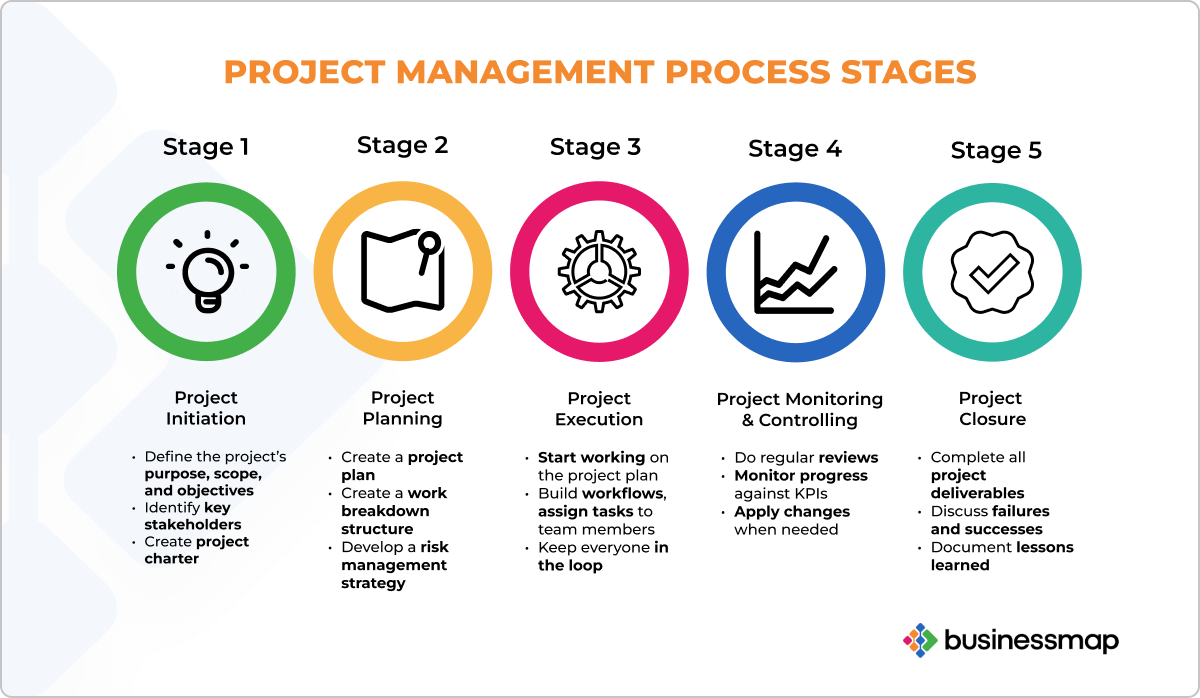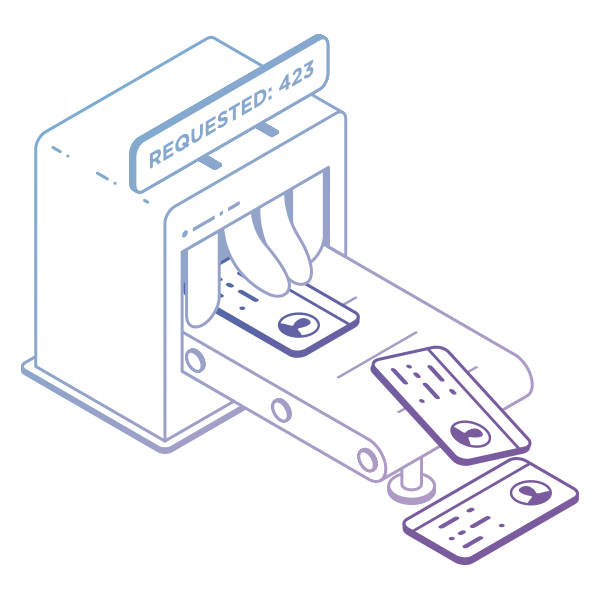In the realm of project management, outcomes vary - some projects thrive, while others falter or stall in their initial stages for various reasons. Notably, nearly 70% of transformation projects around the globe fail, but the challenges it poses are not unique. The inherent unpredictability in project management, shaped by continually shifting demands and business trends, frequently catches organizations off guard, leaving them unready for future uncertainties.
It is vital to understand the project’s goal and how to run one to protect it from falling into the still high project failure rate. A lot goes into the recipe for a successful project delivery. A substantial practice to navigate this pool of ever-changing goals, tasks, and priorities is to follow a well-established process approach.
In this article, we’ll look into the project management process and explore the main stages that help teams complete a project on time and thoroughly.
What Is a Project Management Process?
The project management process is a series of phases or stages a project goes through, from initiation to completion. It provides a framework for organizing and managing various functions and tasks involved in a project. It also coordinates resources and timelines to achieve specific goals within a defined timeline and budget.
Depending on the project management approach that an organization adheres to, project management processes can be more structured or more adaptive.
The Waterfall model, for instance, is a stage-gate project management technique where reviews are conducted before each stage. Organizations ensure that deliverables are completed successfully by following this linear approach, where each phase must be completed before moving on to the next.
On the other hand, the Agile project management process is characterized by its iterative nature, allowing for ongoing adjustments based on continuous feedback, organizational needs, customer input, and evolving project requirements, fostering a more adaptive and flexible approach to project execution.
Whether the project management approach is more structured or flexible, it’s equally important for project managers to have a clear understanding of each phase and engage stakeholders appropriately throughout the lifecycle to ensure successful project delivery.
Understanding the 5 Essential Stages of Project Management
Regardless of the industry in which a business operates or its primary priorities, project management processes include five stages: initiation, planning, execution, monitoring and controlling, and closure. Each stage has its own set of objectives, deliverables, and outcomes that are critical to the project's success.

Let’s break it down and take a closer look at the specifics of each stage.
1. Project Initiation
The project management process begins with the initiation stage. It’s the phase when an idea becomes a meaningful business plan. This stage involves defining the project and its objectives. Before kicking off the project, there are a few questions that need to be answered:
- What is the purpose of the project?
- What are the project’s objectives?
- What kind of resources will be required?
- Are there any potential constraints down the road?
- How much time would it take for the project to be finished?
- Does it have a budget range?
- Who are the stakeholders?
The purpose of this questionnaire is for managers to clearly outline the project's objectives and reasons through a set of formal documents. Some important PM documents include:
-
Business case: a business case explains how a business will benefit from this project. It also justifies various aspects, such as potential obstacles and expenses.
-
Feasibility study: a feasibility study assesses whether the project can be completed within a specified timeframe, considering various factors contributing to its successful completion.
-
Project charter: a project charter focuses on all necessary information about the project – what value it is going to deliver, what needs to be done, what is the expected timeline, what is the budget for the project, who is the assigned project manager, etc.
Clarifying these questions and setting the ground basis for everyone involved is a crucial step for the project’s success. Unclearly defined objectives and their rationale pose a threat, increasing the risk of project failure and failing to meet stakeholders' expectations.
2. Project Planning
Once the project is defined, it enters the planning stage.
The primary goal of this stage involves creating a detailed project plan, which should include the following information:
- setting project goals,
- identifying the deliverables and creating a breakdown structure,
- estimating the time and resources required to complete each task,
- creating a project schedule.
During project planning, you should also create a risk management plan to outline the strategy if any risks occur associated with the project.
Whether you take a more traditional project planning approach or follow some of the Agile methodologies’ guidelines and plan in an Agile way, setting achievable, specific, and measurable goals can be advantageous. To help with that, you can explore some goal-setting methods such as S.M.A.R.T. (Specific, Measurable, Achievable, Realistic, and Timely) or C.L.E.A.R. (Collaborative, Limited, Emotional, Acceptable, and Refined).

3. Project Execution
After the planning stage comes the execution, which is the backbone of a project’s lifecycle. As the name suggests, you are in the process of executing the work identified in the planning phase.
During the project execution, project managers need to manage resources, address and resolve any shortcomings, build efficient workflows, and carefully monitor progress. Moreover, maintaining open communication among project stakeholders ensures that everyone stays informed, promoting smooth project execution and staying on track.
Balancing multiple responsibilities simultaneously can become overwhelming and hinder productivity. To keep up with everything going on, project leaders rely on project management tools to help them track work and collaborate seamlessly with everyone.
4. Project Monitoring and Controlling
The distinction between the project monitoring phase and the project execution stage is subtle, as they often overlap. In this phase, consistent reviews of the project status are crucial to identify and address issues promptly and taking necessary actions when necessary.
Additionally, monitoring the project’s progress against key performance indicators (KPIs) or OKRs (objectives and key results) informs if the project is going in the right direction and is on track.
While in this stage, managers can still make all necessary adjustments to ensure the project is completed successfully and track the project timeline, budget, and quality requirements.
5. Project Closure
At this stage, you want to ensure the stakeholder is satisfied with the project's outcomes. As a final to-do, you can conduct a last project review to identify any lessons learned and document the project results.
The project closure phase marks the formal conclusion of a project and involves several key activities. Firstly, there is a comprehensive review of project deliverables against initial goals and objectives to ensure all requirements are met. Additionally, the closure phase involves releasing project resources, such as team members or equipment, and closing out financial accounts associated with the project.
As a final to-do, project closure includes a final project review to identify any lessons learned and create a final document summarizing key achievements and challenges and outlining the overall project performance.
Most Common Project Management Techniques
Three of the most popular project management approaches include Agile, Lean, and Waterfall.
1. Waterfall is a traditional methodology that follows a linear, sequential approach to project management. In other words, each phase must be completed before the next begins. This method is well-suited for projects with precise and stable requirements.
2. Lean methodology is an approach to project management and production that emphasizes the elimination of waste, continuous improvement, and delivering maximum value to the customer with minimal resources.
-
Kanban is a Lean-derived workflow management method that helps teams visualize work through Kanban boards, optimize work delivery processes, maximize efficiency, and encourage teams to improve continuously.
3. Agile is an iterative and flexible approach focusing on continuous value delivery and emphasizing adaptability, regular feedback, and collaboration. Agile project management is the most effective approach for projects with changing requirements and a need for regular adjustments.
- Scrum is an Agile framework that uses short sprints to release products faster and adapt to changing customer requirements. At its core are cross-functional teams and regular review meetings.
10 Tips to Build a Successful Project Management Process
Here are ten key insights to foster a successful project management process.
- Clearly define project objectives and deliverables.
- Align project deliverables with project objectives.
- Keep communication channels open and transparent among team members and stakeholders.
- Regularly assess and manage risks to prevent potential issues from derailing the project.
- Establish a realistic project timeline with achievable milestones to track progress.
- Ensure that necessary support and resources are provided to team members.
- Regularly monitor resource usage and adjust plans as required.
- Track project performance by implementing an effective monitoring and evaluation system.
- Document lessons learned both successes and areas for improvement.
- Foster a culture for continuous improvement.
We offer the most flexible software platform
for outcome-driven enterprise agility.
In Summary
Successful project management involves a strategic blend of well-defined processes, appropriate methodologies, and ensuring that all aspects of the project are covered. This includes aspects such as scope, schedule, budget, resources, risk management, communication, and stakeholder engagement.
By understanding the main stages, choosing the right approach, and implementing key tips for success, organizations can navigate the complexities of projects and emerge with successful outcomes.
The five-step project management process includes:
- Project Initiation
- Project Planning
- Project Execution
- Project Monitoring and Control
- Project Closure










